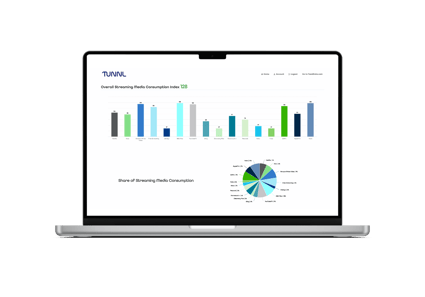Tunnl | Audiences | Media Optimization
Media Fragmentation: How to Make the Most of America’s Divided Attention

Joey currently serves as Tunnl's VP of Business Development.
Gathered around the water cooler, people used to ask each other if they’d caught that one popular TV show that aired the night before. And since there were only about five major channels and everyone had cable, you could almost always count on an affirmative answer. Nowadays, you have to preface that ask with, “Which streaming services do you have right now?”
Screen time is up, but attention is divided. Between streaming connected TV, scrolling social media, playing mobile games, and flipping through linear TV channels, your audience is everywhere.
Media fragmentation is making it difficult for advertisers like you to make an impact with your message and forcing your tried-and-true advertising playbook out the window. Tunnl’s been tracking media consumption behavior across the nation for years, building and refreshing media mixes on hundreds of behavior- and issue-based audiences for TV and digital advertisers. We’ve seen advertisers struggle to sustain their campaign results in an increasingly fragmented media landscape without the right data - and helped them conquer that challenge.
We’ll cover what exactly media fragmentation means for your campaigns, what others are doing to overcome it, and how to make your audience’s divided attention work for you.
What is Media Fragmentation?
Media fragmentation describes how audiences have dispersed across an increasing number of media channels, causing headaches for advertisers.
You’ve probably witnessed the change in your own media consumption habits, let alone that of your target audience.
 US adults get roughly 7 hours of screen time a day, and you can bet they’re not spending it all in one place. Combine that with the number of cord-cutters canceling cable, and you’re left with one resounding conclusion: Audiences have more media options than ever before, and they are making the most it.
US adults get roughly 7 hours of screen time a day, and you can bet they’re not spending it all in one place. Combine that with the number of cord-cutters canceling cable, and you’re left with one resounding conclusion: Audiences have more media options than ever before, and they are making the most it.
That is media fragmentation at work.
But for advertisers, dispersed audiences and divided attention make it more difficult to get reps in with the right people, especially if you’re accustomed to funneling your entire ad budget to linear TV.
“When only about half of the people you want to reach are actually watching linear, it's not going to be as effective anymore,” says Amanda Beadle, Tunnl’s VP of Audiences and Analytics. “You used to be able to trust that you were going to reach a large swath of the country if you put your budget on linear TV. Now, large budgets for TV don't guarantee that you're going to reach everyone you need to be reaching because TV viewership habits have shifted.”
Changes in media consumption patterns don’t necessarily spell disaster for your campaigns as long as you know how to keep up with them.
How are Marketers Responding to Media Fragmentation?
Media fragmentation is more than a passing trend; it won’t be on its way out any time soon, even as streaming services start consolidating into packaged plans (looking at you, Disney+ and Hulu). Your old advertising methods may not be suited to the new normal.
“If advertisers aren't thinking about media fragmentation when they are putting up their buy, and they go with the same playbook that has always worked, they may overspend in areas that are no longer effective with their audience and miss opportunities to connect more efficiently,” says Amanda Beadle, Tunnl’s VP of Audiences and Analytics. “This is especially true with political campaigns, which people tend to say lag behind what brands are trying.”
 For some marketers, this has meant putting more money into linear TV advertising to increase the frequency of their ads, hoping to reach audiences when they are watching traditional TV. That method may work if your audience overwhelmingly prefers linear to connected TV, but it could put you in serious competition with other committed linear advertisers flooding the already-saturated market.
For some marketers, this has meant putting more money into linear TV advertising to increase the frequency of their ads, hoping to reach audiences when they are watching traditional TV. That method may work if your audience overwhelmingly prefers linear to connected TV, but it could put you in serious competition with other committed linear advertisers flooding the already-saturated market.
It also leaves out valuable opportunities to capitalize on media fragmentation based on your audience’s preferences.
Getting aligned with the times and how your audience consumes media is your only answer to sustaining positive campaign performance. Advertisers who have successfully adapted to media fragmentation know this: Understanding media fragmentation isn’t enough; you need to know how your target audience is dispersed across the new media landscape.
How Can I Reach a Fragmented Audience?
If you’re used to linear TV ads and cable ads, you may be accustomed to trusting a content-centric marketing approach. Pick popular shows just about everyone watches or a well-loved program with a demographic that aligns with your campaign, and pay a premium for that ad space in the hopes of reaching the right people. But do you really know if you’ll reach enough of them to make it worth your while?
Media fragmentation exacerbates that uncertainty. With fewer eyes on traditional TV, picking a particular program based on demographics or overall national ratings alone won’t be enough to reach your audience. You need to know they’re watching. But how?
Audience intelligence is your secret weapon against the perils of media fragmentation.
What is audience intelligence? It’s the process of getting to know your target audience - their demographics, values, and media consumption habits - so your ads can reach the right people more often and more efficiently.
Media fragmentation necessitates audience intelligence, and audience intelligence eliminates the unknowns of ad targeting in a distributed, distracted ecosystem. It’s a win-win when you’re apprehensive about deviating from your established strategy because you’ll know you’re making the right placement decisions, especially when you use a trustworthy data source like Tunnl.
Tunnl eliminates the mysteries created by media fragmentation so you can continue resonating with your audience no matter where they are.
Tunnl is the only actionable source for audience intelligence. Our platform provides precise, regularly updated insights into who your audience is and how to reach them most efficiently and effectively across their preferred media channels. Access social, streaming, and linear TV consumption insights + media optimization and planning tools all in one place, making it easy for you to reach your audience and maximize your message's impact despite media fragmentation.
Our full suite of audiences and insights - plus optimization and planning tools for all media channels -enable advertisers to plan the most efficient buys across social, streaming, and linear ad platforms. With tools tailored to help digital and TV advertisers track their audiences' increasingly fragmented media consumption habits, Tunnl is a singular access point for achieving the surround sound effect required to maximize ROI in today’s hyper-saturated ad landscape.
And you’ll never have to choose between finding an audience that cares about your issue or demonstrates a certain behavior, and receiving media consumption data. You get access to both for every audience with Tunnl.
Equipped with reliable, streamlined audience intelligence, you can start reclaiming and redefining strategic opportunities to reach your audience, despite media fragmentation.
3 Advantages of Audience Intelligence Amidst Media Fragmentation
1. Less Competition
Back in the day, when everyone watched broadcast TV and couldn’t imagine life without a cable subscription, linear TV ads were a one-stop shop for reaching your audience. But that meant everyone wanted the same ad space, creating competition and driving up costs.
 Media fragmentation sent audiences scattering across streaming and social networks, giving advertisers a chance to disperse their spends to less competitive spaces - if they know which ones are worth it.
Media fragmentation sent audiences scattering across streaming and social networks, giving advertisers a chance to disperse their spends to less competitive spaces - if they know which ones are worth it.
Media mix insights give you an opportunity to think outside the popular-programing box and explore ad placements on other channels, ad platforms, or mediums. Should your audience index higher than average on a niche form of media, you can circumvent your competition to reach your audience in those lesser traveled - and likely less expensive - locations. Media fragmentation is no match for audience intelligence in most cases.
Keep in mind that less competition is still a far cry from no competition. You will still be entering a saturated ad space, even if you know precisely where to reach your audience for maximum efficiency. No ad platform is free from competition, though some are less competitive than others, which can improve how well you reach your audience with the budget you have.
2. Less Budget Waste
 You may be thinking that an omnichannel advertising approach sounds like more work and more money instead of a streamlined solution. But how much of your current ad spend is actually reaching your target audience? They are dispersed across multiple ad platforms, and your ad budget should be too.
You may be thinking that an omnichannel advertising approach sounds like more work and more money instead of a streamlined solution. But how much of your current ad spend is actually reaching your target audience? They are dispersed across multiple ad platforms, and your ad budget should be too.
There’s no use buying up ad space on oversaturated networks during highly-coveted dayparts if your audience isn’t even watching linear TV very often. They may be browsing TikTok or LinkedIn, too. They may channel hop to Hulu and Roku.
By diversifying your ad spend across the CTV platforms, broadcast networks, and social channels that are most effective with your audience, you trim the fat off your campaigns and take your budget further.
But be careful. A scattered ad portfolio could send your spend upward if you go about it on a platform-by-platform basis without succinct targeting.
“There's a risk that you end up spending more money if you're not being targeted enough and you're just doing lots of direct site buys across streaming platforms,” warns Amanda Beadle. “But there also is a benefit to running a programmatic campaign that targets people who are across streaming platforms where inventory is available to target people who are in your right audience regardless of where they're consuming content.”
To eliminate wasteful spending, trust audience media mixes to guide your buy, even if it means branching out beyond broadcast or keeping the bulk of your spend on cable; your budget should follow your audience’s eyes. And given how fragmented media has become, that’s bound to be several different ad platforms.
Combine less competitive, less expensive, and more targeted media planning into your ad placement strategy, and the resultant elixir is improved reach efficiency for your campaigns.
3. Increased Impact
Your audience needs to see your ad anywhere between 7 and 20+ times before they acknowledge, remember, and act on its message. Media fragmentation makes it difficult for single-channel advertisers to achieve that level of resonance because their audience isn't always around to see their message again and again.
But for advertisers using audience insights to inform an omnichannel presence that follows their targets across their favorite TV, streaming, and social networks, making an impact is inevitable.
Placing your ads in all the locations your audience consumes media creates a surround sound effect that's necessary to drive action in today's fragmented market. Advertisers who understand where, how, and how often their audience consumes media are able to reach their target segments despite media fragmentation because they know how to ensure their ads are seen in precisely the right places by the right people, as many times as it takes.
The result is higher dollar-for-dollar ROAS for insight-driven, omnichannel advertisers who optimize for media fragmentation, rather than battle against its inevitability.
Start Capitalizing on Media Fragmentation for Your Campaigns
We can’t escape media fragmentation, so you may as well make the most of it. The best way to do that is to invest in an audience intelligence solution that can help you track your audience across the great wide world of media that seems ever-expanding.
There are plenty of options to choose from in the audience intelligence space, so read up on what’s out there to find a good match for your campaigns.
Tunnl, for example, offers end-to-end audience intelligence to help you maximize your ROI across channels. Our TV Ratings and Reach & Frequency solutions help you identify the most efficient ways to reach your audience on broadcast TV and beyond to achieve incremental reach. And our media mixes give you a roadmap of where your ad dollars can deliver the most bang for your buck.
Media fragmentation is an opportunity, not a setback. And now you’re ready to seize it.


